
Fighter aircraft are military aircraft designed primarily for air-to-air combat. In military conflict, the role of fighter aircraft is to establish air superiority of the battlespace. Domination of the airspace above a battlefield permits bombers and attack aircraft to engage in tactical and strategic bombing of enemy targets, and helps prevent the enemy from doing the same.

The Phalanx CIWS is an automated gun-based close-in weapon system to defend military watercraft automatically against incoming threats such as aircraft, missiles, and small boats. It was designed and manufactured by the General Dynamics Corporation, Pomona Division, later a part of Raytheon. Consisting of a radar-guided 20 mm (0.8 in) Vulcan cannon mounted on a swiveling base, the Phalanx has been used by the United States Navy and the naval forces of 15 other countries. The U.S. Navy deploys it on every class of surface combat ship, except the Zumwalt-class destroyer and San Antonio-class amphibious transport dock. Other users include the British Royal Navy, the Royal Australian Navy, the Royal New Zealand Navy, the Royal Canadian Navy, and the U.S. Coast Guard.

An interceptor aircraft, or simply interceptor, is a type of fighter aircraft designed specifically for the defensive interception role against an attacking enemy aircraft, particularly bombers and reconnaissance aircraft. Aircraft that are capable of being or are employed as both "standard" air superiority fighters and as interceptors are sometimes known as fighter-interceptors. There are two general classes of interceptor: light fighters, designed for high performance over short range; and heavy fighters, which are intended to operate over longer ranges, in contested airspace and adverse meteorological conditions. While the second type was exemplified historically by specialized night fighter and all-weather interceptor designs, the integration of mid-air refueling, satellite navigation, on-board radar, and beyond visual range (BVR) missile systems since the 1960s has allowed most frontline fighter designs to fill the roles once reserved for specialized night/all-weather fighters.

An autocannon, automatic cannon or machine cannon is a fully automatic gun that is capable of rapid-firing large-caliber armour-piercing, explosive or incendiary shells, as opposed to the smaller-caliber kinetic projectiles (bullets) fired by a machine gun. Autocannons have a longer effective range and greater terminal performance than machine guns, due to the use of larger/heavier munitions, but are usually smaller than tank guns, howitzers, field guns, or other artillery. When used on its own, the word "autocannon" typically indicates a non-rotary weapon with a single barrel. When multiple rotating barrels are involved, such a weapon is referred to as a "rotary autocannon" or occasionally "rotary cannon", for short.
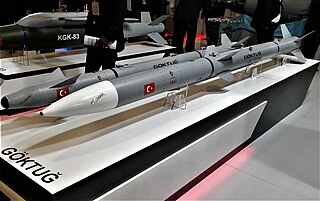
An air-to-air missile (AAM) is a missile fired from an aircraft for the purpose of destroying another aircraft. AAMs are typically powered by one or more rocket motors, usually solid fueled but sometimes liquid fueled. Ramjet engines, as used on the Meteor, are emerging as propulsion that will enable future medium- to long-range missiles to maintain higher average speed across their engagement envelope.

The RIM-7 Sea Sparrow is a U.S. ship-borne short-range anti-aircraft and anti-missile weapon system, primarily intended for defense against anti-ship missiles. The system was developed in the early 1960s from the AIM-7 Sparrow air-to-air missile as a lightweight "point-defense" weapon that could be retrofitted to existing ships as quickly as possible, often in place of existing gun-based anti-aircraft weapons. In this incarnation, it was a very simple system guided by a manually aimed radar illuminator.
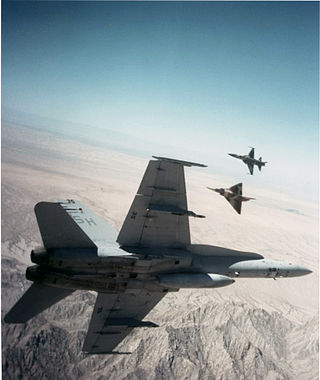
Air combat manoeuvring (ACM) is the tactic of moving, turning, and situating one's fighter aircraft in order to attain a position from which an attack can be made on another aircraft. Commonly associated with dogfighting, air combat manoeuvres rely on offensive and defensive basic fighter manoeuvring (BFM) to gain an advantage over an aerial opponent.
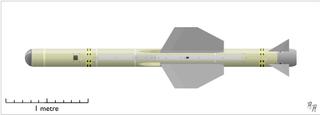
The Hawker Siddeley Red Top was the third indigenous British air-to-air missile to enter service, following the de Havilland Firestreak and limited-service Fireflash. It was used to replace the Firestreak on the de Havilland Sea Vixen and later models of the English Electric Lightning.

The Douglas F6D Missileer was a proposed carrier-based fleet defense fighter designed by Douglas Aircraft Company in response to a 1959 United States Navy requirement. It was designed to be able to loiter for extended periods at a relatively long distance from the Navy's aircraft carriers, engaging hostile aircraft 100 miles (160 km) away with its powerful radar and long-range missiles. Since the enemy would be fired on long before they reached visual range, the aircraft had little dogfighting capability and was strictly subsonic. When doubts were expressed about the Missileer's ability to defend itself after firing its missiles, the value of the project was questioned, leading to its cancellation. Some of the Missileer's systems, primarily the engines, radar, and missiles, continued development in spite of the cancellation, eventually emerging on the ill-fated General Dynamics–Grumman F-111B and successful Grumman F-14 Tomcat years later.
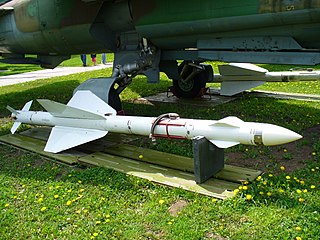
The Vympel R-23 is a medium-range air-to-air missile developed by Vympel in the Soviet Union for fighter aircraft. An updated version with greater range, the R-24, replaced it in service. It is comparable to the American AIM-7 Sparrow, both in terms of overall performance as well as role.
In military aviation, a head-on engagement is one where a surface-to-air missile system or jet aircraft engages another aircraft while the target aircraft is flying towards the attacker. This makes engagement with infrared homing missiles more difficult because the hot engine exhaust nozzle(s) of the target are pointing away from the attacker. Typically only all-aspect infra-red homing missiles are able to perform head-on engagements. Radar-guided missiles are typically able, however head-on many aircraft have a much smaller radar cross-section so the radar may not be able to track/lock onto the target at maximum range in this type of engagement.

A fire-control system (FCS) is a number of components working together, usually a gun data computer, a director and radar, which is designed to assist a ranged weapon system to target, track, and hit a target. It performs the same task as a human gunner firing a weapon, but attempts to do so faster and more accurately.

In aerobatics, the cobra maneuver, also called dynamic deceleration, among other names, is a dramatic and demanding maneuver in which an airplane flying at a moderate speed abruptly raises its nose momentarily to a vertical and slightly past vertical attitude, causing an extremely high angle of attack and momentarily stalling the plane, making a full-body air brake before dropping back to normal position, during which the aircraft does not change effective altitude.

The MIM-72A/M48 Chaparral is an American-made self-propelled surface-to-air missile system based on the AIM-9 Sidewinder air-to-air missile system. The launcher is based on the M113 family of vehicles. It entered service with the United States Army in 1969 and was phased out between 1990 and 1998. It was intended to be used along with the M163 VADS, the Vulcan ADS covering short-range short-time engagements, and the Chaparral for longer range use.

Basic fighter maneuvers (BFM) are tactical movements performed by fighter aircraft during air combat maneuvering, to gain a positional advantage over the opponent. BFM combines the fundamentals of aerodynamic flight and the geometry of pursuit, with the physics of managing the aircraft's energy-to-mass ratio, called its specific energy.
The scissors is an aerial dogfighting maneuver commonly used by military fighter pilots. It is primarily a defensive maneuver, used by an aircraft that is under attack. It consists of a series of short turns towards the attacking aircraft, slowing with each turn, in the hopes of forcing the attacker to overshoot. Performed properly, it can cause the attacking aircraft to move far enough in front to allow the defender to turn the tables and attack.

Anti-surface warfare is the branch of naval warfare concerned with the suppression of surface combatants. More generally, it is any weapons, sensors, or operations intended to attack or limit the effectiveness of an adversary's surface ships. Before the adoption of the submarine and naval aviation, all naval warfare consisted of anti-surface warfare. The distinct concept of an anti-surface warfare capability emerged after World War II, and literature on the subject as a distinct discipline is inherently dominated by the dynamics of the Cold War.
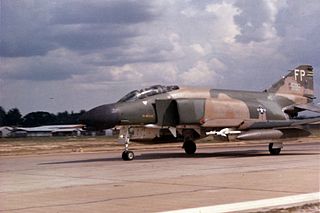
Operation Bolo was a United States Air Force mission during the Vietnam War, considered to be a successful combat ruse.

Multiservice tactical brevity codes are codes used by various military forces. The codes' procedure words, a type of voice procedure, are designed to convey complex information with a few words.

A missile approach warningsystem (MAW) is part of the avionics package on some military aircraft. A sensor detects attacking missiles. Its automatic warning cues the pilot to make a defensive maneuver and deploy the available countermeasures to disrupt missile tracking.

















